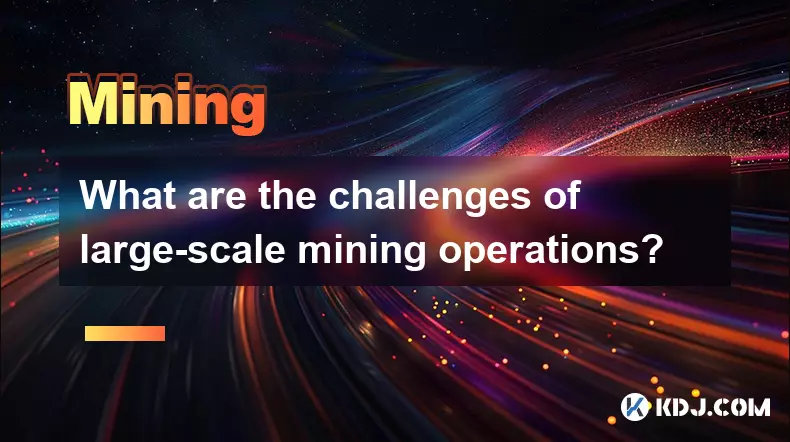-
 bitcoin
bitcoin $108221.513755 USD
-0.10% -
 ethereum
ethereum $3817.049350 USD
-1.16% -
 tether
tether $1.000184 USD
-0.03% -
 bnb
bnb $1081.373706 USD
1.55% -
 xrp
xrp $2.367284 USD
-2.30% -
 solana
solana $180.847708 USD
-3.07% -
 usd-coin
usd-coin $0.999936 USD
0.00% -
 tron
tron $0.322230 USD
-0.06% -
 dogecoin
dogecoin $0.190590 USD
-1.92% -
 cardano
cardano $0.626657 USD
-2.42% -
 hyperliquid
hyperliquid $37.280123 USD
6.15% -
 chainlink
chainlink $17.222315 USD
-2.46% -
 ethena-usde
ethena-usde $0.999312 USD
-0.03% -
 stellar
stellar $0.309699 USD
-0.98% -
 bitcoin-cash
bitcoin-cash $475.445788 USD
-1.02%
What are the challenges of large-scale mining operations?
Large mining farms face high energy costs, hardware wear, and regulatory risks, requiring robust infrastructure, maintenance, and adaptive strategies to remain profitable.
Oct 18, 2025 at 07:01 pm

Energy Consumption and Power Management
1. Large-scale mining operations require massive amounts of electricity to power thousands of ASICs or GPUs running continuously. This leads to extremely high operational costs, especially in regions where energy prices are not subsidized.
2. Stable and uninterrupted power supply is critical; any outage can halt mining activity, resulting in immediate revenue loss and potential hardware damage due to improper shutdowns.
3. Many mining farms are relocating to areas with cheap hydroelectric, geothermal, or stranded energy sources, but infrastructure limitations in these remote locations often complicate setup and maintenance.
4. Regulatory scrutiny around carbon emissions has increased pressure on miners to adopt renewable energy sources, forcing a shift toward greener solutions even when they are less economically favorable in the short term.
5. Power distribution within large facilities must be meticulously planned to prevent overloads, requiring industrial-grade transformers, cooling systems, and redundant circuits.
Hardware Logistics and Maintenance
1. Procuring tens of thousands of mining rigs involves complex supply chain coordination, including customs clearance, import taxes, and manufacturer lead times that can stretch for months during peak demand.
2. Continuous wear and tear from non-stop operation results in frequent hardware failures, necessitating dedicated technical teams and spare parts inventories to minimize downtime.
3. Firmware updates, overclocking configurations, and performance monitoring must be managed at scale, often through centralized control software that introduces its own vulnerabilities and compatibility issues.
4. Dust accumulation, humidity, and poor ventilation accelerate component degradation, making environmental controls an essential part of daily operations.
5. Disposal or resale of obsolete equipment presents both logistical and environmental challenges, particularly as newer models rapidly outpace older generations in efficiency.
Regulatory and Legal Risks
1. Jurisdictional regulations vary widely, with some countries banning cryptocurrency mining outright while others impose strict licensing requirements and reporting obligations.
2. Sudden policy changes can render entire operations unviable overnight, as seen in past crackdowns in China and Iran, where fleets were seized or forced to shut down without compensation.
3. Compliance with anti-money laundering (AML) and know-your-customer (KYC) frameworks is increasingly expected, even for mining entities, complicating relationships with exchanges and payout processors.
4. Tax treatment of mined coins differs across borders, affecting profitability calculations and requiring specialized accounting practices to track hash rate income, depreciation, and capital gains.
5. Local communities may oppose large mining projects due to noise pollution, grid strain, or environmental concerns, leading to public backlash and political intervention.
Frequently Asked Questions
How do large mining farms handle internet connectivity issues?Mining farms deploy redundant fiber-optic lines from multiple providers to ensure constant connection to the blockchain network. Even brief disconnections can result in orphaned blocks and lost rewards, so uptime is prioritized with backup routing and on-site network engineers.
What happens when a mining farm becomes unprofitable?Operators may repurpose facilities for alternative computational tasks like AI training or data hosting, though retrofitting costs can be prohibitive. Some choose to relocate to lower-cost regions, while others liquidate hardware and exit the market entirely.
Are mining pools necessary for large operations?While large farms can mine independently, most still join pools to smooth out reward variance. Pools allow consistent payouts by combining hash power with other miners, reducing the risk of long dry spells between block discoveries.
How is heat generated by mining equipment managed?Industrial-scale cooling systems such as HVAC units, exhaust fans, and immersion cooling tanks are used to maintain optimal temperatures. In colder climates, some operators redirect waste heat to nearby buildings or greenhouses to offset energy waste.
Disclaimer:info@kdj.com
The information provided is not trading advice. kdj.com does not assume any responsibility for any investments made based on the information provided in this article. Cryptocurrencies are highly volatile and it is highly recommended that you invest with caution after thorough research!
If you believe that the content used on this website infringes your copyright, please contact us immediately (info@kdj.com) and we will delete it promptly.
- Essex Post Office, 5p Coins, and King Charles: A Royal Mint Revelation!
- 2025-10-23 10:30:16
- Waymo's Newark Airport AV Tests: Alphabet's AI Gamble Pays Off?
- 2025-10-23 10:30:16
- King Charles 5p Coins: A Royal Flush in Your Pocket?
- 2025-10-23 10:35:18
- Solana, Crypto Advisory, and Forward Industries: A New York Minute on the Future of Finance
- 2025-10-23 08:51:22
- MAGACOIN: Ethereum Whales Dive into the Hottest Presale of 2025
- 2025-10-23 08:51:22
- Kadena's End of the Road? KDA Token Plummets Amid Project Abandonment
- 2025-10-23 08:55:34
Related knowledge

A simple explanation of the Bitcoin mining process
Oct 21,2025 at 05:54am
What Is Bitcoin Mining?1. Bitcoin mining is the process by which new bitcoins are introduced into circulation and transactions are verified on the blo...

How to get started with Litecoin mining?
Oct 19,2025 at 07:01am
Understanding Litecoin Mining Basics1. Litecoin mining involves verifying transactions on the Litecoin blockchain using computational power. Miners so...

What are the challenges of large-scale mining operations?
Oct 18,2025 at 07:01pm
Energy Consumption and Power Management1. Large-scale mining operations require massive amounts of electricity to power thousands of ASICs or GPUs run...

How to manage the heat and noise from a mining rig?
Oct 22,2025 at 05:36pm
Optimizing Ventilation for Mining Rigs1. Proper airflow is essential when running a mining rig continuously. Position the rig in a well-ventilated roo...

Can a Raspberry Pi be used for crypto mining?
Oct 21,2025 at 04:18pm
Feasibility of Using Raspberry Pi for Cryptocurrency Mining1. The Raspberry Pi is a compact, low-power single-board computer designed primarily for ed...

What is the break-even point for a mining investment?
Oct 21,2025 at 03:36am
Understanding the Break-Even Point in Cryptocurrency MiningThe break-even point in cryptocurrency mining refers to the moment when the total revenue g...

A simple explanation of the Bitcoin mining process
Oct 21,2025 at 05:54am
What Is Bitcoin Mining?1. Bitcoin mining is the process by which new bitcoins are introduced into circulation and transactions are verified on the blo...

How to get started with Litecoin mining?
Oct 19,2025 at 07:01am
Understanding Litecoin Mining Basics1. Litecoin mining involves verifying transactions on the Litecoin blockchain using computational power. Miners so...

What are the challenges of large-scale mining operations?
Oct 18,2025 at 07:01pm
Energy Consumption and Power Management1. Large-scale mining operations require massive amounts of electricity to power thousands of ASICs or GPUs run...

How to manage the heat and noise from a mining rig?
Oct 22,2025 at 05:36pm
Optimizing Ventilation for Mining Rigs1. Proper airflow is essential when running a mining rig continuously. Position the rig in a well-ventilated roo...

Can a Raspberry Pi be used for crypto mining?
Oct 21,2025 at 04:18pm
Feasibility of Using Raspberry Pi for Cryptocurrency Mining1. The Raspberry Pi is a compact, low-power single-board computer designed primarily for ed...

What is the break-even point for a mining investment?
Oct 21,2025 at 03:36am
Understanding the Break-Even Point in Cryptocurrency MiningThe break-even point in cryptocurrency mining refers to the moment when the total revenue g...
See all articles










































































